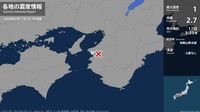At around 5:33 AM on April 17, 2025, residents of Wakayama Prefecture experienced a minor earthquake that registered a maximum seismic intensity of 1. According to the Japan Meteorological Agency (JMA), the epicenter of the quake was located in the northern part of the prefecture, specifically at coordinates 34.2 degrees north latitude and 135.3 degrees east longitude. The depth of the earthquake was approximately 10 kilometers, and it was estimated to have a magnitude of 2.7.
The earthquake was felt most strongly in Wakayama City, where the seismic intensity reached level 1. Fortunately, there is no concern regarding a tsunami as a result of this seismic event. The JMA has been actively providing detailed seismic intensity information by region, ensuring that residents are kept informed about the situation.
This latest tremor adds to the ongoing seismic activity in Japan, a country well-known for its geological volatility due to its position along the Pacific Ring of Fire. Earthquakes are a common occurrence, and the Japanese government has implemented extensive measures to prepare for and respond to such natural disasters.
In recent years, Japan has experienced several notable earthquakes, some of which have caused significant damage and loss of life. The government encourages residents to be prepared for future quakes, emphasizing the importance of having emergency kits and plans in place.
While the magnitude of this earthquake was relatively low, it serves as a reminder of the importance of earthquake preparedness. Local authorities in Wakayama have reiterated their commitment to public safety, urging residents to stay informed and ready for any potential aftershocks.
As seismic monitoring continues, the JMA will provide updates and alerts to ensure that the public is aware of any changes in seismic activity. The agency also encourages residents to report any unusual occurrences or damage they may experience as a result of this earthquake.
In the wake of the quake, community leaders in Wakayama City have organized meetings to discuss emergency response strategies and to review existing safety protocols. These discussions are vital, as they help to strengthen community resilience in the face of natural disasters.
Overall, while the earthquake on April 17 was minor and caused no immediate concerns, it highlights the necessity for ongoing vigilance and preparedness among the residents of Wakayama Prefecture. The JMA continues to monitor the situation closely, ensuring that the public remains informed about any developments.
As Japan moves forward, the experience gained from these seismic events contributes to a broader understanding of earthquake behavior and risk management, fostering a culture of preparedness that is essential for safeguarding lives and property.






